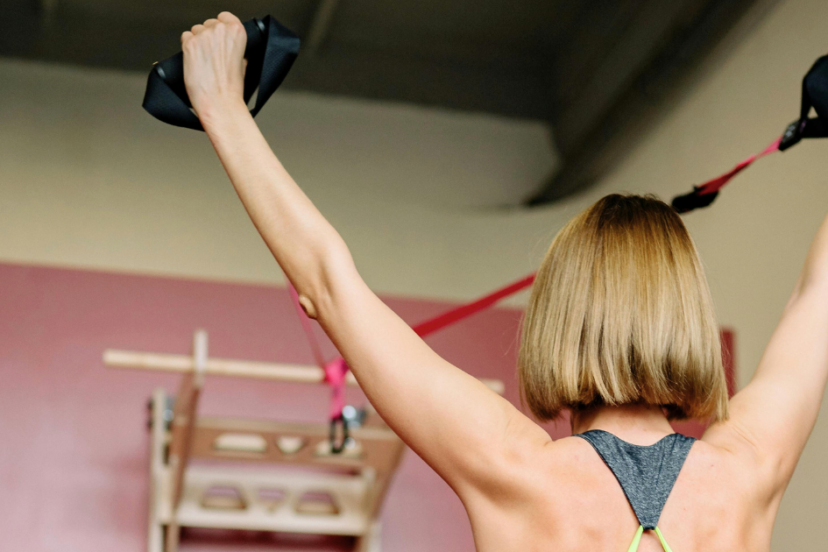Cable Back Exercises: Get a Stronger Back & Better Posture
Struggling with back pain or just looking to improve your strength? Cable back exercises are a fantastic way to target every part of your back, from the upper to lower muscles, while reducing strain and improving posture. In this guide, I’ll walk you through the top cable exercises, offer tips for proper form, and show you how to incorporate them into your routine. Plus, I’ll share must-have tools and product recommendations for reducing back pain while sleeping and enhancing your overall back health.
Introduction

Let’s talk about something we often take for granted: our back muscles. Whether it’s sitting for long hours at a desk, lifting heavy objects, or simply carrying around daily stress, our back bears the brunt. But here’s the thing – back pain doesn’t have to be a constant companion. Cable back exercises are not only a fantastic way to strengthen your back, but they can also help with improving posture, preventing injuries, and reducing discomfort. I’m going to guide you through some of the best cable back exercises, proper form tips, and product recommendations, so you can strengthen your back and even fix those nagging back pains you might feel after sleeping!
Benefits of Cable Back Exercises

1. Increased Muscle Engagement
Cable exercises provide consistent tension throughout the movement, engaging multiple muscle groups in your back. Unlike free weights, which rely on gravity, cables allow you to work against resistance in various directions, leading to better muscle activation.
1: Engage your core throughout each exercise. A strong core supports your lower back and helps prevent strain.
2: Focus on the squeeze at the top of each rep to maximize muscle contraction.
3: Use a full range of motion—don’t shortchange your back muscles by limiting the movement.
4: If you struggle with upper back pain after sleeping, start incorporating cable rows into your routine. They strengthen the muscles responsible for better posture, which can alleviate sleep-related discomfort.
5: Switch up your grip! Using different grips (wide, neutral, or underhand) can help target different areas of your back, ensuring comprehensive development.
2. Versatility in Workouts
One of the greatest things about cable machines is how versatile they are. You can switch from lat pulldowns to face pulls or rows with just a quick change of attachments. This variety makes it easier to hit every part of your back without needing multiple machines.
1: Incorporate cable rows, face pulls, and lat pulldowns into one workout for a balanced back routine.
2: For those days when you’re in a rush, focus on compound movements like cable rows that target multiple muscle groups.
3: Adjust the angle of the cable to focus on different parts of your back.
4: Don’t forget about unilateral exercises like the single-arm cable row to fix imbalances in your muscle development.
5: Add bands to your cable exercises to increase resistance and further engage stabilizer muscles.
3. Safer for Joint Health
Cables provide a smooth, controlled movement, reducing the stress on your joints. This is crucial, especially if you’re prone to lower back pain or stiffness after sleeping. If you often wake up with back pain, cable exercises can be a great way to build back strength without risking joint injury.
1: Always control the movement and avoid using momentum.
2: If you experience lower back pain while sleeping, cable exercises may strengthen the muscles that support your spine, reducing discomfort at night.
3: Use lighter weights with higher reps to avoid straining your joints.
4: Focus on your form—bad posture during cable exercises can contribute to joint discomfort.
5: Consider using a back brace during your workouts if you’re recovering from an injury to ensure proper alignment and support.
Product Recommendation:
- Top-rated Back Brace for Support – Ideal for protecting your spine and promoting proper form during back exercises.
4. Improved Posture
Good posture doesn’t just look better—it also prevents pain. Poor posture can lead to upper back pain from sleeping and tension throughout the day. Cable exercises that focus on the upper back and shoulders are particularly good for improving posture.
1. Cable face pulls are amazing for strengthening the rear deltoids and upper traps, which are key for pulling your shoulders back.
2: Strengthening the upper back reduces slouching, which can lead to better breathing and less fatigue.
3: Include exercises like the cable pullover to open up the chest and shoulders.
4: Stretch your chest muscles after every workout to ensure your posture remains balanced.
5: Consider using a posture corrector during the day to reinforce good habits.
Product Recommendation:
- Posture Corrector for All-Day Use – Helps keep your back aligned and reduces the strain that leads to bad posture.
5. Suitable for All Fitness Levels
Whether you’re a beginner just starting out or an experienced lifter, cable exercises are for you. The resistance can be easily adjusted to match your strength level, and the variety of movements ensures that there’s something for everyone.
1: If you’re new to back exercises, start with low resistance and focus on mastering form.
2: Gradually increase the weight as your strength improves.
3: For more experienced lifters, try supersets or drop sets to push your muscles to their limit.
4: Use different attachments like ropes, handles, or bars to keep your workouts fresh.
5: Beginners should focus on compound movements like cable rows, while advanced lifters can incorporate isolation exercises like face pulls.
Top Cable Back Exercises

Cable Row
The cable row is a classic exercise that targets your entire back, particularly the lats, rhomboids, and traps. It’s perfect for those who suffer from upper back pain after sleeping as it strengthens the muscles that help maintain proper posture.
1: Keep your back straight and avoid rounding your shoulders.
2: Focus on pulling the handles toward your belly button for maximum lat activation.
3: Squeeze your shoulder blades together at the top of the movement.
4: If you’re experiencing upper back pain, avoid using excessive weight.
5: Perform 3-4 sets of 10-12 reps for optimal strength and posture improvement.
Product Recommendation:
- Best Cable Row Attachment – Enhance your cable row experience with this ergonomically designed attachment.
Lat Pulldown
Lat pulldowns are fantastic for targeting the large latissimus dorsi muscles, helping you build that classic V-shaped back. This exercise can also improve posture, which helps relieve back pain from sleeping.
1: Keep your chest up and pull the bar to your upper chest.
2: Use a wider grip to target the outer lats for a broader back.
3: Avoid leaning back too far—this takes the focus off your lats.
4: Perform 3 sets of 8-10 reps with a challenging weight.
5: For added variety, try underhand or neutral grips to change the muscle activation.
Product Recommendation:
- Top Lat Pulldown Bar – Designed to provide comfort and control during lat pulldowns, helping you target the lats more effectively.
Face Pull
Face pulls are an essential exercise for developing the rear delts and upper traps. If you struggle with poor posture or upper back pain from sleeping, this exercise is a must.
1: Pull the cable towards your face, keeping your elbows high.
2: Focus on squeezing your shoulder blades together to engage the traps.
3: Keep the movement controlled—don’t let the weights pull you forward.
4: Perform 3 sets of 12-15 reps for strength and endurance.
5: Face pulls are great for preventing rounded shoulders, which can cause upper back pain.
Product Recommendation:
- Face Pull Rope Attachment – A durable rope attachment to ensure you’re getting the most out of your face pulls.
Cable Pullover
This exercise is fantastic for targeting the lats while also engaging the core. It’s a great addition to any back routine and helps stretch out tight muscles that might contribute to lower back pain from sleeping.
1: Keep your arms slightly bent throughout the movement to avoid strain on the elbows.
2: Focus on the stretch at the top of the movement to fully engage the lats.
3: Use a slow, controlled tempo, especially on the eccentric (lowering) phase to maximize tension on the lats.
4: Make sure to keep your core tight throughout the exercise to avoid arching your lower back.
5: Aim for 3-4 sets of 10-12 reps for hypertrophy, adjusting the weight as needed to maintain proper form.
Product Recommendation:
- Best Pullover Bar Attachment – Perfect for isolating the lats during pullovers and ensuring a smooth, ergonomic motion.
Single-Arm Cable Row
Unilateral exercises like the single-arm cable row are fantastic for fixing muscle imbalances. If you notice one side of your back is stronger or larger than the other, incorporating this exercise is a must.
1: Keep your core tight and your torso stable to avoid twisting.
2: Focus on driving your elbow back rather than just pulling with your hand to maximize lat engagement.
3: Perform 3 sets of 10-12 reps on each side, making sure both sides get equal attention.
4: Don’t rush the reps—control the weight on both the lifting and lowering phases.
5: Use a full range of motion to fully engage your lats and traps.
Product Recommendation:
- Top Cable Row Handle – Ensures a comfortable and controlled grip during single-arm rows, helping you target the back muscles more effectively.
Addressing Back Pain with Cable Back Exercises
Upper Back Pain After Sleeping
Waking up with upper back pain can be a real struggle, often due to poor posture, tight muscles, or an inadequate sleep setup. Cable exercises that strengthen the upper back can go a long way in alleviating this pain.
1: Focus on exercises like face pulls and cable rows to strengthen the muscles that support better posture.
2: Try incorporating stretches like the lat stretch to relieve tightness in your upper back.
3: Use a pillow designed for back pain (more on that below) to ensure your upper back is supported during sleep.
4: Cable exercises like rear delt flys are great for strengthening the smaller muscles in the upper back that can often be overlooked.
5: Make sure you’re maintaining good posture throughout the day to prevent further issues.
Product Recommendation:
- Best Pillow for Back Pain – Provides proper support for your upper back while sleeping, reducing pain and discomfort.
Lower Back Pain After Sleeping
Lower back pain after sleeping is another common issue, and it can be exacerbated by weak or tight muscles in the lower back. Cable back exercises can help strengthen these muscles and improve your posture, reducing the likelihood of pain.
1: Start incorporating exercises like the cable pullover and cable row to build lower back strength.
2: Use a back brace during workouts to help with alignment and avoid aggravating existing pain.
3: Strengthening your core with cable ab exercises can also support your lower back and help alleviate pain.
4: Make sure you’re using proper form during all exercises to avoid straining the lower back.
5: Adjust your sleep position—sleeping on your back with a supportive pillow can help relieve lower back pain (more on that below).
Product Recommendation:
- Best Back Brace for Sleeping – Provides support and alignment while you sleep, reducing strain on the lower back.
How Cable Back Exercises Improve Sleep and Relieve Pain
One of the key ways to prevent or relieve back pain is by adopting a proper sleeping position. Poor sleeping posture is one of the leading causes of back pain, but cable exercises can help build the strength needed to maintain good posture even when lying down.
Best Sleeping Positions for Back Pain
1: Sleeping on your back is widely regarded as the best position for those with back pain. It keeps your spine aligned and reduces unnecessary pressure on the lower back.
2: Use a pillow under your knees to help support your spine’s natural curve and relieve lower back pain.
3: If you prefer to sleep on your side, place a pillow between your knees to maintain proper spinal alignment.
4: Avoid sleeping on your stomach, as this position places excessive stress on the spine and can lead to morning stiffness.
5: Consider investing in a mattress that provides adequate support for your back—one that isn’t too soft or too firm.
Product Recommendation:
• Best Pillow for Back Sleepers – Designed to provide optimal support for your spine when sleeping on your back, ensuring a comfortable and pain-free night’s sleep.
Strengthening Core Muscles for Better Sleep
Strengthening your core is essential for better posture and back health. When your core muscles are weak, it puts more strain on your back, which can exacerbate pain both during the day and at night. Cable exercises are a great way to strengthen your core, which in turn will improve your sleep quality.
1: Cable ab exercises like cable crunches and cable woodchoppers can help strengthen your core while also engaging your back muscles.
2: Incorporate planks or side planks using a cable machine to challenge your core stability.
3: Strengthening your core can help reduce lower back pain, making it easier to fall asleep and stay asleep without discomfort.
4: Use a foam roller to stretch and massage your lower back after core exercises to promote relaxation before bed.
5: Make sure you’re breathing correctly during your exercises—engaging your diaphragm during lifts will activate your core and protect your back.
Product Recommendation:
• Best Foam Roller for Back Pain Relief – Use this after your workout to relieve tension in the lower back and promote relaxation before sleep.
Pillow and Sleep Setup Recommendations for Back Pain Relief
Best Pillows for Upper and Lower Back Pain
The pillow you use can have a major impact on the quality of your sleep and how you feel the next morning. For those dealing with back pain, choosing the right pillow is crucial.
1: Choose a pillow that supports the natural curve of your spine—memory foam or orthopedic pillows work best for this.
2: For upper back pain, consider a cervical pillow that supports the neck and shoulders, helping to keep your upper spine aligned while you sleep.
3: If you suffer from lower back pain, using a lumbar pillow or placing a pillow under your knees can help relieve pressure on your lower back.
4: Adjust your pillow height based on your sleeping position—back sleepers generally need a thinner pillow, while side sleepers might benefit from a thicker one.
5: Replace your pillow regularly—old pillows can lose their shape and support, contributing to back pain.
Product Recommendation:
- Best Pillow for Lower Back Pain – Provides lumbar support during sleep, helping to alleviate lower back pain.
Mattress Recommendations for a Pain-Free Sleep
Your mattress is another critical component of your sleep setup. If your mattress is too soft or too firm, it can exacerbate back pain, making it harder to get a restful night’s sleep.
1: Opt for a medium-firm mattress that provides the right balance of support and cushioning. This can help relieve pressure points and keep your spine aligned.
2: Look for a mattress with good lumbar support to help reduce lower back pain while sleeping.
3: If you have an old mattress that’s starting to sag, it’s time to replace it—an unsupportive mattress is a common cause of back pain.
4: Consider a mattress topper if replacing your mattress isn’t an option. A memory foam or latex topper can provide additional support and comfort.
5: Make sure your mattress is compatible with your sleeping position—side sleepers typically need a softer mattress, while back sleepers benefit from firmer support.
Product Recommendation:
• Top-rated Mattress for Back Pain – Provides the optimal combination of support and comfort for individuals suffering from back pain.
Conclusion

Cable back exercises are an excellent way to build strength, improve posture, and alleviate pain, whether it’s from poor posture or a bad night’s sleep. By incorporating these exercises into your fitness routine, you’ll not only strengthen your back but also prevent future injuries and promote a healthier spine. Pairing these exercises with the right sleep setup, including supportive pillows and mattresses, will help you wake up feeling refreshed and pain-free.
FAQs
1. What are the best cable back exercises for improving posture?
Cable rows, face pulls, and lat pulldowns are some of the best cable back exercises for improving posture. These exercises target the upper back muscles, which help pull the shoulders back and support proper alignment.
2. How can cable back exercises help relieve upper back pain from sleeping?
Strengthening your upper back with cable exercises like face pulls and rows improves posture, which can reduce tension and pain from poor sleeping positions. A stronger back supports better alignment, which alleviates discomfort.
3. What’s the difference between free weights and cable exercises for back muscles?
Free weights rely on gravity and provide resistance in one direction, while cable exercises offer consistent tension throughout the entire range of motion. Cables allow for more versatile movement patterns, engaging multiple muscle groups at once.
4. How often should I perform cable back exercises to see results?
Aim for 2-3 times per week, allowing your muscles to recover between sessions. Consistency is key—within a few weeks, you should start noticing improved strength and posture.
5. Can cable exercises help with lower back pain?
Yes! Cable exercises like rows and pullovers engage and strengthen the muscles that support the spine, which can help alleviate lower back pain. Make sure to maintain proper form to avoid straining your lower back further.
*We may earn a commission from purchases made through our links, at no cost to you. This does not affect our product recommendations. Please see our disclosure to learn more.
![Urban Health Hive]](https://urbanhealthhive.com/wp-content/uploads/2023/05/cropped-cropped-Health_Logo.png)



